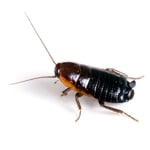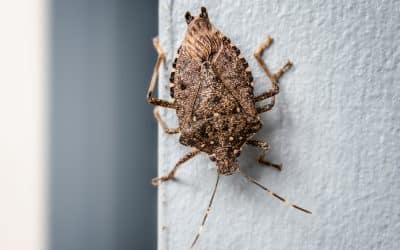
Pest Identification: Oriental Roaches
Oriental cockroaches are often called water bugs because of their preference for dark, damp, and cool areas such as those under sinks and washing machines, and in damp basements. The most important aspect of these cockroaches derives from their habit of feeding and living in damp and unsanitary places such as sewers, garbage disposals, kitchens, bathrooms, and indoor storage areas. Filth from these sources can be spread by cockroaches to food supplies, food preparation surfaces, dishes, utensils, and other surfaces. Cockroaches contaminate far more food than they are able to eat.
Adult Oriental cockroaches are about one inch in length. Both male and female adults are very dark brown, to nearly black. Females have small, functionless, rudimentary wing pads and broader, heavier bodies. Males have wings that cover only about three-quarters of their abdomen. Males are apparently unable to fly. The Oriental cockroach has three developmental stages: egg, nymph, and adult. Eggs are laid in capsules, which the female carries for about 30 hours and then drops onto a protected surface near a food supply.
Females produce an average of eight capsules, each containing 16 eggs that hatch in about 60 days under room temperature conditions. Nymphs molt from seven to ten times; nymphal stages usually take 24 to 130 weeks to complete. The life span of an adult female is 5 to 26 weeks with approximately 200 offspring.
If water is available, they can live for a month without food; without water they die within two weeks. Food poisoning, dysentery and diarrhea are the principal diseases transmitted by Oriental cockroaches. The insects carry these disease-causing organisms on their legs and bodies and deposit the organisms on food and utensils as they hunt for food. Cockroach excrement and cast skins also contain a number of allergens, which can cause skin rashes, watery eyes, congestion of nasal passages, asthma, and sneezing.
Cooperation of the homeowners by removing food, moisture, and harborages for cockroaches—is the first step in treatment. Eliminating cockroach harborages involves caulking in closets and cabinets, caulking under the sink, etc., or making similar structural repairs in the kitchen, bathroom, and other areas of the house.

Buzzwords
Flea FAQs: What You Need to Know
We’ve all been there: that tiny black spec…did it just move? If you’re a homeowner, few things can spark panic faster than spotting a flea in your carpet, on your bedding, or crawling on your pet. Fleas are annoying, but they also bite, can spread disease, and turn...
Bug Off! Keeping Stink Bugs Out of Your Home
Fall in New England brings crisp air, colorful leaves, and stink bugs. As soon as the temperatures start to dip, stink bugs start searching for a cozy spot to ride out the winter, and your home is often their top choice. Unless you know how to stop them. With a few...
Protect Your Lawn: What You Need to Know About Grubs
You work hard to maintain a beautiful yard. But if you start noticing unexplained patches or spongy turf, grubs might be the culprit. These pesky beetle larvae feed on grass roots, turning lush lawns into a patchy mess. Bottom line: they are a threat to your yard....

